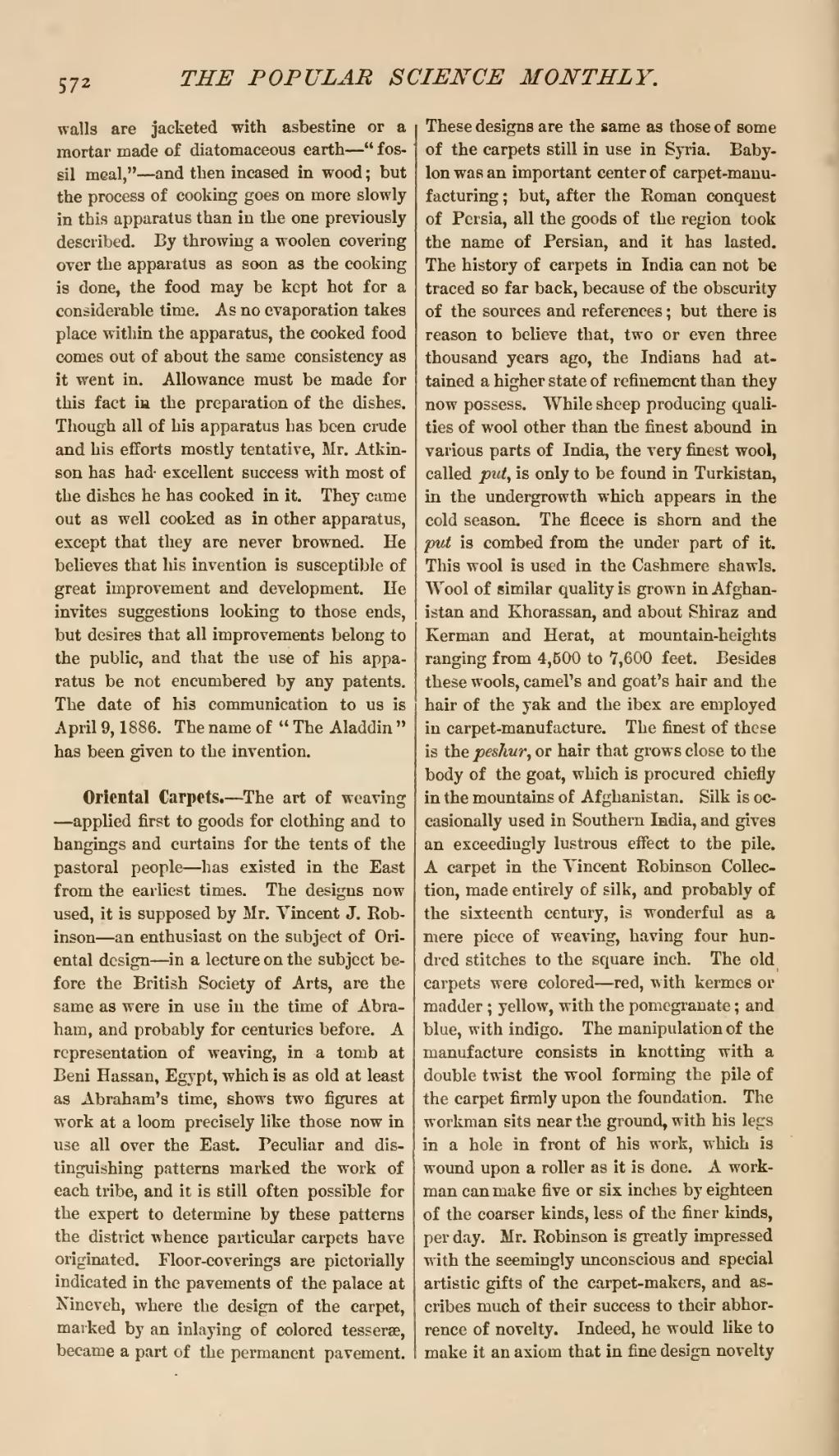walls are jacketed with asbestine or a mortar made of diatomaceous earth—"fossil meal,"—and then incased in wood; but the process of cooking goes on more slowly in this apparatus than in the one previously described. By throwing a woolen covering over the apparatus as soon as the cooking is done, the food may be kept hot for a considerable time. As no evaporation takes place within the apparatus, the cooked food comes out of about the same consistency as it went in. Allowance must be made for this fact is the preparation of the dishes. Though all of his apparatus has been crude and his efforts mostly tentative, Mr. Atkinson has had-excellent success with most of the dishes he has cooked in it. They came out as well cooked as in other apparatus, except that they are never browned. He believes that his invention is susceptible of great improvement and development. He invites suggestions looking to those ends, but desires that all improvements belong to the public, and that the use of his apparatus be not encumbered by any patents. The date of his communication to us is April 9, 1886. The name of "The Aladdin" has been given to the invention.
Oriental Carpets. The art of weaving applied first to goods for clothing and to hangings and curtains for the tents of the pastoral people—has existed in the East from the earliest times. The designs now used, it is supposed by Mr. Vincent J. Robinson—an enthusiast on the subject of Oriental design in a lecture on the subject before the British Society of Arts, are the same as were in use in the time of Abraham, and probably for centuries before. A representation of weaving, in a tomb at Beni Hassan, Egypt, which is as old at least as Abraham's time, shows two figures at work at a loom precisely like those now in use all over the East. Peculiar and distinguishing patterns marked the work of each tribe, and it is still often possible for the expert to determine by these patterns the district whence particular carpets have originated. Floor-coverings are pictorially indicated in the pavements of the palace at Nineveh, where the design of the carpet, marked by an inlaying of colored tesseræ, became a part of the permanent pavement. These designs are the same as those of some of the carpets still in use in Syria. Babylon was an important center of carpet-manufacturing; but, after the Roman conquest of Persia, all the goods of the region took the name of Persian, and it has lasted. The history of carpets in India can not be traced so far back, because of the obscurity of the sources and references; but there is reason to believe that, two or even three thousand years ago, the Indians had attained a higher state of refinement than they now possess. While sheep producing qualities of wool other than the finest abound in various parts of India, the very finest wool, called put, is only to be found in Turkistan, in the undergrowth which appears in the cold season. The fleece is shorn and the put is combed from the under part of it. This wool is used in the Cashmere shawls. Wool of similar quality is grown in Afghanistan and Khorassan, and about Shiraz and Kerman and Herat, at mountain-heights ranging from 4,500 to 7,600 feet. Besides these wools, camel's and goat's hair and the hair of the yak and the ibex are employed in carpet-manufacture. The finest of these is the peshur, or hair that grows close to the body of the goat, which is procured chiefly in the mountains of Afghanistan. Silk is occasionally used in Southern India, and gives an exceedingly lustrous effect to the pile. A carpet in the Vincent Robinson Collection, made entirely of silk, and probably of the sixteenth century, is wonderful as a mere piece of weaving, having four hundred stitches to the square inch. The old carpets were colored—red, with kermes or madder; yellow, with the pomegranate; and blue, with indigo. The manipulation of the manufacture consists in knotting with a double twist the wool forming the pile of the carpet firmly upon the foundation. The workman sits near the ground, with his legs in a hole in front of his work, which is wound upon a roller as it is done. A workman can make five or six inches by eighteen of the coarser kinds, less of the finer kinds, per day. Mr. Robinson is greatly impressed with the seemingly unconscious and special artistic gifts of the carpet-makers, and ascribes much of their success to their abhorrence of novelty. Indeed, he would like to make it an axiom that in fine design novelty
